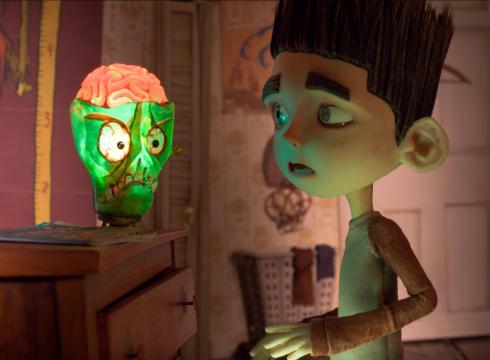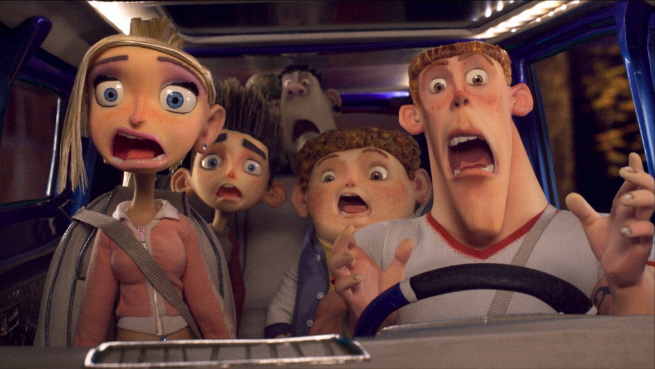by Raj Ranade
A few thoughts about ParaNorman, the new animated film from the stop-motion studio Laika (the team behind the excellent Coraline).
– Stop-motion animation has had a minor comeback in recent years – ParaNorman is one of three stop-motion wide releases in 2012 alone (along with Pirates: Band of Misfits and Tim Burton’s upcoming Frankenweenie). And ParaNorman is perhaps the most polished, glossy example of the genre ever made, thanks to a high-tech three-dimensional printing process that allows for an unprecedented degree of precision in the faces of the film’s puppets. Tech websites have reported breathlessly about the advances made – instead of the 200,000 expressions achievable on Coraline‘s puppets, the studio can now create 1.5 million expressions on ParaNorman’s creepy creatures. It’s as close to CG animation as stop-motion has ever gotten – which kind of misses the point of stop-motion animation.
It’s not that I’m categorically opposed to computer-aided precision in my animation (fill in your own list of gorgeous Pixar/Dreamworks animation here). But the limitations of stop-motion are as much the point of the format as anything else. It’s the handcrafted imperfections of the style that paradoxically make it as interesting as it is – you sense the labor and craftsmanship of human hands behind the scenes instead of machine tooling or bit manipulation. ParaNorman is still a very impressive looking film – the overall art design is moody and clever, and the sets and backdrops have the appealingly real textures of actual wood and water and fabric, instead of CG facsimiles – but the increasingly CG-styled slickness of the film’s character models seems like a step in the wrong direction.
In an interview, directors Chris Butler and Sam Fell suggested that the old, imperfection-laden style was “distracting to the performances”, but I don’t buy that. It’s not like these characters feel more emotionally rich than the ones in Coraline because they’re technically capable of expressing so many more emotions – the opposite, in fact, is true, and that has far more to do with the writing than anything else. (Besides, I think I’m probably only capable of correctly intuiting fifty or so different emotions from a face anyway – less if we’re talking about my girlfriend.)
It’s all particularly odd when you consider how much directors Chris Butler and Sam Fell clearly adore the ramshackle low-budget horror movies of the 80s. The film, which centers on a horror-movie obsessed moppet who sees dead people, lovingly spoofs the sloppy, seams-showing filmmaking of these movies from its very first scene (imagine a cuddlier version of the fake horror movie trailers in Grindhouse). You’d think they would recognize how appealing a little sloppiness can be.
– I don’t want to be too hard on ParaNorman, though, because it is a fun little romp with an unexpectedly bold third act. Most of the film, which finds Norman mocked by friends and family for his conversations with the invisible dead until visible undead come to town, proceeds in the postmodern style of something like Shrek instead of a Pixar-style sincerity. There’s the typical mix of kid-friendly slapstick along with the pop-culture references that will sail over their heads (if someone told me a decade ago that grime rapper Dizzee Rascal would have been featured in both the Olympic opening ceremony and an animated kid flick, oh, how I would have laughed). There’s also, unfortunately, a somewhat bland set of stock types around our likeably morose young protagonist, though these are livened up a little by fun voiceover work from Anna Kendrick (as Norman’s mean-girl sister) and Christopher Mintz-Plasse (McLovin voices a school bully here in a nice little meta-joke).
But the film enters deeper and darker territory when the secrets behind the zombie uprising start to be revealed. In a nod to George Romero’s classics, we find out that threatened townspeople can be as horrific as their decomposing counterparts. And where the film starts out seeming like a set-up for a Revenge-of-the-Nerd style scenario, it ends as a sort of rebuke to that idea – the last thirty minutes turn this film into a story about historical cycles of fear and revenge, as well as the importance of forgiveness. It’s an impressively complex and mature take on those ideas, if it is a somewhat awkward fit with the spoofy rest of the film (inevitable Pixar comparison: note how a similar shift in Brave was both surprising as it happens and completely justified in retrospect). And it makes you realize that the only reason ParaNorman isn’t in the highest echelon of animated features is that the bar for the genre is so remarkably high.










